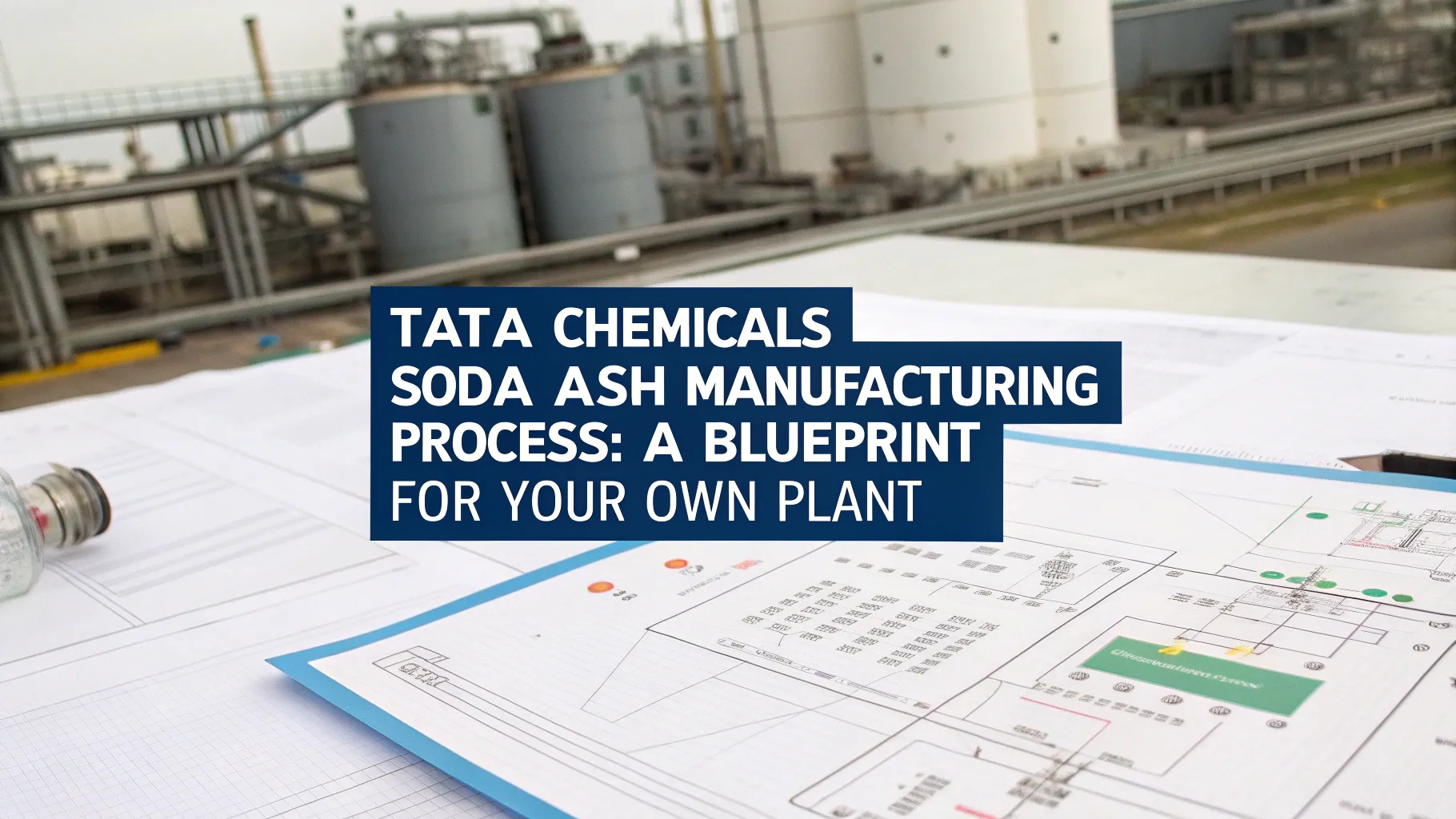Introduction: A Forgotten Industrial Hero
In the grand conversation around innovation and startups, the focus often leans toward software, e-commerce, and AI. Yet, Tata chemicals quietly power every corner of our modern world—from the glass in your windows and screens to the detergents in your home and the lithium batteries in your electric vehicle. At the heart of this industrial backbone lies a vital compound: soda ash.
Among global producers, Tata Chemicals has emerged as a leader in both scale and sustainability. With plants in India, the UK, Kenya, and the U.S., the company is at the forefront of soda ash innovation. But the real story here is not just about Tata’s success—it’s about how you can follow a similar path. This isn’t a closed club. With the right planning, tech, and partners, a first-generation entrepreneur or MSME can launch a profitable soda ash plant.
Why Soda Ash Has Moved Back Into the Spotlight
Soda ash is traditionally linked to glass and detergents, but recent shifts in energy, environment, and consumer markets have significantly broadened its relevance. It is now a crucial component in solar panel glass, water treatment systems, textile dyeing processes, and the processing of lithium carbonate—a key raw material in electric vehicle batteries. As the world transitions toward clean energy and smart infrastructure, demand for soda ash is no longer just stable—it is accelerating.
In India, domestic demand already exceeds 4.5 million metric tonnes annually, and market trends suggest a rise to over 6.5 million metric tonnes by 2030. This growth is not speculative; it is anchored in rapid industrialization, expanding middle-class consumption, and government mandates for water sanitation and renewable energy. Countries across Asia and Africa are also importing increasing volumes of soda ash, offering export potential for any producer with a cost-efficient operation. For the right entrepreneur, this is a golden alignment of market pull, supply chain gaps, and scalable technology.
Related: Profitable Opportunities in India’s Soda Ash Business Industry
Decoding the Tata Model: Natural vs Synthetic Soda Ash
The Trona-Based Natural Process (Magadi, Kenya)
Tata Chemicals Magadi facility in Kenya operates near Lake Magadi, a natural trona deposit. This is one of the cleanest sources of sodium carbonate in the world. Here, soda ash is made from naturally occurring sodium sesquicarbonate.
The process is elegant and sustainable:
- Slurry is pumped from the lakebed using dredgers.
- This is washed and filtered to remove silts and impurities.
- The purified slurry undergoes calcination in rotary kilns, producing dense soda ash.
- After cooling and grading, the final product is packaged and shipped globally.
Unlike synthetic processes, this method has a lower carbon footprint, and Tata’s facility makes efficient use of solar drying and minimal water withdrawal.
The Solvay Process at Mithapur, Gujarat
Closer to home, Tata Chemicals’ Mithapur facility in Gujarat produces soda ash through the Solvay process, one of the most widely used synthetic methods globally.
It begins by reacting brine and ammonia with carbon dioxide, generating sodium bicarbonate crystals. These are filtered, washed, and calcined to produce soda ash. Importantly, both ammonia and CO? are recycled back into the system, minimizing waste and cost.
Tata’s process is energy-optimized through co-generation systems, smart waste recovery, and IoT-enabled monitoring. Their transition to digital twins helps forecast yield, predict maintenance needs, and reduce downtimes.
Inside Tata Chemicals’ Dual Manufacturing Strategy
Tata Chemicals has built its global capacity through two distinct but equally sophisticated processes: the natural soda ash process and the synthetic Solvay process. Understanding both is critical for anyone looking to enter this space.
At Lake Magadi in Kenya, Tata harnesses one of the world’s few naturally occurring trona deposits. The trona slurry is dredged directly from the lakebed, a process that avoids traditional mining and minimizes environmental disruption. This slurry is purified to remove silts and insoluble materials and is then sent through rotary kilns for calcination, converting the trona into high-grade soda ash crystals. The result is a dense, durable product with minimal residual waste and a relatively low carbon footprint. The simplicity and sustainability of this model make it a prime candidate for replication in regions with similar natural resources.
In Gujarat, the Mithapur facility showcases a different strategy—one built around the Solvay process. This synthetic approach uses brine, limestone, and ammonia in a series of chemical reactions, beginning with the creation of ammoniated brine and followed by carbonation to form sodium bicarbonate crystals. These crystals are filtered, washed, and then calcined to yield soda ash. A key feature of this process is the regeneration and recycling of ammonia and carbon dioxide, reducing both operating cost and waste generation. Over decades, Tata has embedded co-generation, digital automation, and zero liquid discharge principles into this facility, turning it into one of the most advanced chemical plants in the country.
Related: Electrolytic Manganese Dioxide Production: Analyzing Techno-Economic Feasibility
Engineering the Plant: From Concept to Commercialization
To emulate the Tata model, a startup must understand not only the chemistry but the broader engineering ecosystem that supports production. Every soda ash plant—regardless of size—relies on a series of interlinked operations. It begins with material preparation, where raw salt and limestone are processed for purity and granulometry. Ammonia storage and circulation systems are designed with pressure integrity and leak management in mind, given the chemical’s volatility.
The heart of the operation lies in the carbonation and calcination units. Carbonation requires precise control of temperature and CO? flow to achieve maximum reaction efficiency. Calcination, meanwhile, is an energy-intensive stage that transforms sodium bicarbonate into soda ash through thermal decomposition. To reduce energy costs, many plants today integrate waste heat recovery systems or deploy fluidized bed calciners with variable speed drives and real-time monitoring.
Water and air management are equally important. Plants must include filtration units, dewatering systems, and condensate recovery to ensure environmental compliance. Effluent treatment, dust collection, and chimney emissions must meet increasingly strict regulatory norms, especially for plants located near urban or agricultural zones. Automating these utilities not only enhances compliance but improves overall operational stability.
Sustainability as Strategy, Not Slogan
Tata’s journey has proven that sustainability is no longer a trade-off; it is a strategic advantage. Their plants use zero freshwater intake for process operations, relying instead on recycled water and steam condensate recovery. Most critically, they’ve reduced CO? emissions through the deployment of energy-efficient combustion systems, optimizing not just the environment but also the bottom line.
New entrants can now integrate similar practices using low-cost digital meters, real-time emission sensors, and cloud-linked water audits. By designing sustainability into the plant from day one, startups can qualify for government subsidies, green finance, and ESG-compliant procurement partnerships. This is no longer optional. It is the new benchmark for chemical manufacturing in India.
Digital Twin Technology and AI Integration
What once required large human teams is now done faster and more reliably with Digital Twins and Industrial AI. Tata Chemicals uses Digital Twin simulations to:
- Optimize yield under varying weather conditions (e.g., brine concentration)
- Predict failure in kilns and filters before it occurs
- Maintain consistent quality through AI-aided lab testing
A startup may not have Tata’s capital—but modular SCADA systems, low-cost IoT sensors, and cloud-based analytics dashboards are now affordable and easy to integrate in plants of all sizes.
You can build a Smart Soda Ash Plant 1.0, even with a 25 TPD capacity, that competes with mid-sized legacy plants.
Indian Market Outlook: Demand Drivers and Opportunity Zones
The expansion of infrastructure, consumer goods, and clean tech in India offers a multi-directional demand pull for soda ash.
Indian Soda Ash Demand Forecast (2025–2030)
| Year | Domestic Demand (MMT) | Top Sectors |
| 2025 | 4.5 | Flat glass, detergents, textiles |
| 2026 | 4.8 | Lithium batteries, solar glass |
| 2027 | 5.2 | Pulp and paper, water treatment |
| 2028 | 5.6 | Paints, agrochemicals |
| 2029 | 6.1 | Export to Southeast Asia |
| 2030 | 6.6 | Green industrial chemicals |
States like Gujarat, Rajasthan, Andhra Pradesh, Tamil Nadu, and Odisha are ideal for setting up plants due to proximity to ports, industrial clusters, and raw materials.
Why Entrepreneurs Should Not Ignore This Sector
If you’re building your first industrial venture, soda ash may not seem glamorous—but it’s:
- High-demand
- Asset-intensive (barrier to entry = less competition)
- Repeat-sale business model (clients buy monthly/quarterly)
- Expandable into adjacent chemicals (baking soda, silicates, percarbonates)
It’s not just a product—it’s a platform. With one plant and the right consulting support, you can build a vertically integrated chemical business.
You don’t need ?500 crore. You can start at ?10–15 crore with a modular plant and scale gradually.
For more information watch our video about this article
What Ratan Tata’s Vision Teaches Aspiring Entrepreneurs
When Ratan Tata steered Tata Chemicals toward sustainability and global expansion, he was not following trends—he was defining them. He believed in building institutions that outlast individuals, in aligning business with societal benefit, and in leading with ethical innovation.
His approach teaches us that manufacturing is not just about margins; it is about mastery. It is about building with care, with commitment to quality, with a long view of impact. Entrepreneurs entering the chemical space must carry this ethos forward. Long-term thinking, process excellence, and an unwavering commitment to transparency and sustainability are what differentiate legacy creators from short-term players.
How NPCS Helps You Start Strong and Scale Wisely
At NIIR Project Consultancy Services (NPCS), we work with entrepreneurs across India and abroad to transform industrial ideas into fully operational businesses. Our expertise in the soda ash sector spans feasibility planning, engineering design, vendor selection, regulatory mapping, and startup strategy.
We help you understand what technology is right for your region, how to size your plant based on current demand and logistics, and how to ensure compliance with pollution and safety boards from day one. More importantly, we help you develop a scalable, bankable business model that goes beyond just project reports—it becomes your roadmap for success.
With over 45 years of experience, our team understands the gaps, risks, and potential of setting up specialty manufacturing in India. Our reports are not just documents; they are decisions backed by data.
Final Thought: Be the Next Chapter in India’s Industrial Legacy
Soda ash may not have the glamour of software or the virality of a consumer app. But it is exactly the kind of foundational industry India needs—resilient, export-oriented, and critical to modern life. Tata Chemicals has shown what’s possible with the right mix of science, ethics, and ambition.
Now, it’s your turn.






